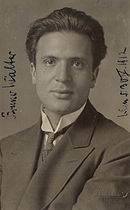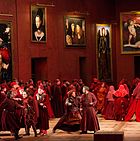Opera casts at the Salzburg Festival from 1935 to 1937
The opera line-ups for the Salzburg Festival 1935 to 1937 include all new productions of the Salzburg Festival in the years 1935 to 1937, in which the festival was shaped by the conductors Arturo Toscanini and Bruno Walter . Both were convinced anti-National Socialists and positioned the festival as a place of internationality and humanity. This period ended with the annexation of Austria by the German Reich in March 1938. Toscanini then refused to return to Salzburg, Walter was forced to emigrate.
New productions
The years 1935 to 1937 were particularly successful for the Salzburg Festival. The number of festival tickets sold rose from 53% in 1934 to 89% in 1937. Every year Toscanini conducted Beethoven's freedom opera Fidelio and an elaborate new production, which every year caused fear and horror for those responsible in Salzburg due to its high costs. The choice of works was dictatorially made by him alone: in 1935 he decided that he wanted to present Verdi's late work Falstaff . A taboo break and the first Verdi production in the history of the festival. In 1936 he positioned Salzburg with his new production of the Meistersinger von Nürnberg as anti-Bayreuth and insisted that Wagner's works belong to world culture and not to the National Socialists. (The Mastersingers were Hitler's favorite opera.) The later Festival President Josef Kaut criticized Toscanini's decision in the 1982 retrospective as “more of a political demonstration than an artistic one”. In 1937 he finally presented Mozart's central opera The Magic Flute , a production that was musically half-baked, but was received with high approval by the press and the public.
Bruno Walter was one of the few conductors who - despite the different styles - was highly valued by Toscanini. He also expanded the Salzburg repertoire and had already presented two Gluck operas there in 1930 and 1931 : Iphigénie en Aulide and Orfeo ed Euridice . In 1936 he conducted a new production of Gluck's Orpheus setting . Otherwise he concentrated on central works by Mozart, Don Giovanni , The Abduction from the Seraglio and Le nozze di Figaro . And he presented Wolf's Der Corregidor and Weber's Euryanthe for the first time in Salzburg , two seldom played works that fit well into the program. Regarding Wagner, Walter shared Toscanini's opinion and insisted on the resumption of the great love opera Tristan und Isolde in Salzburg with an excellent cast, led by Anny Konetzni and Josef Kalenberg .
1935
| Orchestra, choir, conductor | Direction, set design, costumes | singers | Singer | |||||
|---|---|---|---|---|---|---|---|---|
| The Abduction from the Seraglio by Johann Gottlieb Stephanie and Wolfgang Amadeus Mozart - August 12, 21 and 29 | ||||||||
|
Vienna Philharmonic Vienna State Opera Choir Bruno Walter |
Herbert Graf Oskar Strnad set design |
Margherita Perras Konstanze Margit Bokor / Lotte Schöne Blondchen |
Alfred Muzzarelli Bassa Selim Charles Kullmann Belmonte William Wernigk Pedrillo Berthold Sterneck / Ludwig Hofmann Osmin |
|||||
| Falstaff and Arrigo Boito and Giuseppe Verdi - July 29th, August 3rd, 17th and 26th | ||||||||
|
Vienna Philharmonic Vienna State Opera Choir Arturo Toscanini |
Guido Salvini Robert Kautsky , Ladislaus Coppel Margarete Wallmann choreography |
Maria Caniglia / Dusolina Giannini Mrs. Alice Ford Edith Mason Nannetta Angelica Cravcenco Mrs. Quickly Mita Vasari Mrs. Meg Page |
Mariano Stabile Sir John Falstaff Piero Biasini Ford Dino Borgioli Fenton Angelo Badà Dr. Cajus Giuseppe Nessi Bardòlfo Fernando Autori Pistòla |
|||||
1936
1937
Resumptions
In addition to the new productions, the following productions were resumed between 1934 and 1937:
1935
- Così fan tutte , Dir. Felix von Weingartner - August 5th and 19th
- Don Giovanni , Dir. Bruno Walter - August 1st, 8th, 15th, 23rd and 28th
- Fidelio , Sub. Arturo Toscanini - August 7th, 14th, 24th and 31st
- Le nozze di Figaro , Dir. Felix von Weingartner - August 13th and 30th
- Der Rosenkavalier , Dir. Josef Krips - July 30th, August 9th and 27th
- Tristan and Isolde , Dir. Bruno Walter - July 27th
1936
- Così fan tutte , Dir. Felix von Weingartner - July 29th and August 25th
- Don Giovanni , Dir. Bruno Walter - July 28th, August 4th, 13th and 24th
- Falstaff , Sub. Arturo Toscanini - July 31, August 10, 20 and 26
- Fidelio , Sub. Arturo Toscanini - July 25, August 5, 16 and 31
- Le nozze di Figaro , Dir. Felix von Weingartner - July 27th and August 29th
- Tristan and Isolde , Dir. Bruno Walter - August 27th
1937
- Don Giovanni , Dir. Bruno Walter - August 2nd, 13th and 28th
- Elektra , Sub. Hans Knappertsbusch - August 8th and 22nd
- Falstaff , Sub. Arturo Toscanini - July 26th, August 9th and 23rd
- Fidelio , Sub. Arturo Toscanini - August 24th and 26th
- The Mastersingers of Nuremberg , Dir. Arturo Toscanini - August 5th, 12th and 20th
- Orfeo ed Euridice , Dir. Bruno Walter - July 31st and August 14th
- Der Rosenkavalier , Dir. Hans Knappertsbusch - July 27th, August 6th and 24th
See also
source
- Josef Kaut : The Salzburg Festival 1920-1981, With a list of the works listed and the artists of the theater and music by Hans Jaklitsch . Residenz Verlag, Salzburg 1982, ISBN 3-7017-0308-6 .
Individual evidence
- ↑ Toscanini's decision turned out to be suitable for the Salzburg program in retrospect. Falstaff became a Salzburg classic, conducted in 1957 and 1981/82 by Herbert von Karajan , 1993 by Sir Georg Solti , 2001 by Lorin Maazel and 2013 by Zubin Mehta .
- ↑ Josef Kaut: The Salzburg Festival 1920-1981 , With a list of the works listed and the artists of the theater and music by Hans Jaklitsch. Salzburg: Residenz Verlag 1982. ISBN 3-7017-0308-6 . P. 44.
- ↑ Stephen Gallup: The history of the Salzburg Festival , Vienna: Orac 1989, ISBN 3-7015-0164-5 , pp. 124–154 (chapter: The glorious Toscanini).
- ^ Robert Kriechbaumer: Between Austria and Greater Germany. A political history of the Salzburg Festival 1933–1944. Vienna: Böhlau 2013, ISBN 978-3-205-78941-3 , in particular pp. 77–79, 125–136, 142–144, 257–262.


